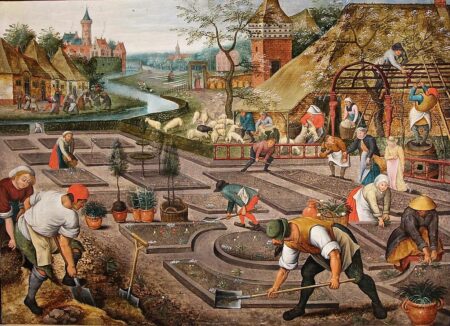- Gastropod episode on The Fruit that Could Save the World. Any guesses what that might be?
- Atlas Obscura podcast on an apparently now famous wild-harvested chocolate from Bolivia. But how wild is it really?
- BBC podcast on cacao for balance.
- Forbes touts an African cassava revolution. What, no podcast?
- Very interesting piece from the ever reliable Modern Farmer on how a small seed company called Fedco Seeds designated a bunch of maize landraces as “indigenously stewarded,” and are paying 10% of what they make from the sale of their seeds to a pooled Indigenous fund which goes to support a local, multi-tribal project called Nibezun. A sort of mini-MLS? Definitely worth a podcast. Any takers?
- A long but rewarding article in New Lines Magazine describes medieval cookbooks from the Abbasid caliphate. The recipes make up for the somewhat stilted podcast.
- BGCI publication on how the Morton Arboretum works out whether it should be growing a particular population or species of tree. The trick is to quantify 5 types of “value”: environmental, evolutionary, genetic diversity, horticultural, conservation. Though one could also consider hostorical/cultural, educational and economic value as well. I suspect in the end it comes down to whether it looks nice in an available gap. If I were to do a podcast on this, I’d test it out with the tree in the first of these Nibbles.
Brainfood: Human diversity, Wild rye, Caribbean cassava, Three Sisters, Old beer, Old apples, Feral crops, Crop resynthesis
- Palaeogenomics of Upper Palaeolithic to Neolithic European hunter-gatherers. Farmers may have pushed hunter-gatherers to the northern edge of Europe while also in mixing with them.
- Identification and exploitation of wild rye (Secale spp.) during the early Neolithic in the Middle Euphrates valley. Those Europeans on the move — both farmers and hunter-gatherers — would have been familiar with wild rye, but that’s pretty much gone from the Fertile Crescent now.
- Caribbean Deep-Time Culinary Worlds Revealed by Ancient Food Starches: Beyond the Dominant Narratives. But enough about Europe. It wasn’t always all about cassava in the pre-colonial, and indeed colonial, Caribbean…
- Reuniting the Three Sisters: collaborative science with Native growers to improve soil and community health. …as there was also the maize/beans/squash system in that part of the world, and may well be again.
- Understanding Early Modern Beer: An Interdisciplinary Case-Study. Something else that could come back is early modern Irish beer, and I’d be there for that.
- Forgotten forest relics: Apple trees (Malus spp.) in eastern U.S. forests. Old abandoned orchards, and escapes therefrom, could have lots of interesting apple diversity. Early modern American cider, anyone?
- Building a feral future: Open questions in crop ferality. And it’s not just apples. It’s a whole movement in fact.
- Resynthesized Rapeseed (Brassica napus): Breeding and Genomics. Sure, we can rebuild it, we have the technology. But will it go feral on us again?
Spring forward!
Pieter Breughel the Younger, CC BY-SA 4.0, via Wikimedia Commons
Nibbles: ICRISAT breeding, India climate change, Seed catalogues, Karabakh horse
- New ICRISAT varieties of sorghum, pearl millet and pigeonpea are doing well in drought-hit Kenya. For now, at least: something to keep an eye on. Genebanks and breeding to the rescue?
- It’s behind a Times of India paywall, alas, but this seems to be an article about the effects of a very warm February on wheat, vegetables and grapes in that country.
- Spring is coming to the northern hemisphere, so of course The New Yorker has a piece on the allure of seed catalogues. I hope there are drought-tolerant and heat-resistant varieties in there. And that they’re clearly labelled as such.
- Meanwhile, oblivious of it all, AramcoWorld has an elegiac piece on the revival of the Karabakh horse in Azerbaijan. Beautiful plumage.
Nibbles: Vavilov, Argentine genebank, Millennium Seed Bank, Indian millets, Community seedbank, Creative finance, Healthy diets, African agriculture
- The Living Library of Resilience is a great name for what Nikolai Vavilov put together, and this longish piece from Maria Popova at The Marginalian is a great tribute to a great man.
- Vavilov’s example is being followed in Argentina, it seems, with the establishment of another genebank, in Corrientes.
- The Millennium Seed Bank reaches an important milestone. Vavilov would be proud.
- Can’t help thinking Vavilov would also wholeheartedly approve of grassroots Indian efforts to bring back millets, as usefully summarized The Locavore. Could have said a bit more about genebanks, though.
- Even genebanks like that of farmers such as Manas Ranjan Sahu. You don’t have to run an institute like Vavilov to build a genebank.
- The Global Alliance for the Future of Food and Transformational Investing in Food Systems Initiative (TIFS) have a report out on Mobilizing Money and Movements: Creative Finance for Food Systems Transformation. No genebanks in there either, alas, but there could so easily have been.
- FAO says billions of people in the world cannot afford a healthy diet, and it has the data to prove it. Does that mean genebanks are not doing their job (eg on nutrient dense orphan crops)? Or doing it too well (eg on the major calorie-rich staples)?
- African worthies say that we need to ramp up investment in the adaptation of agriculture on the continent to climate change. I hope that will include investment in Living Libraries of Resilience that conserve all manner of interesting local crops and varieties. And creative finance for them of course.
